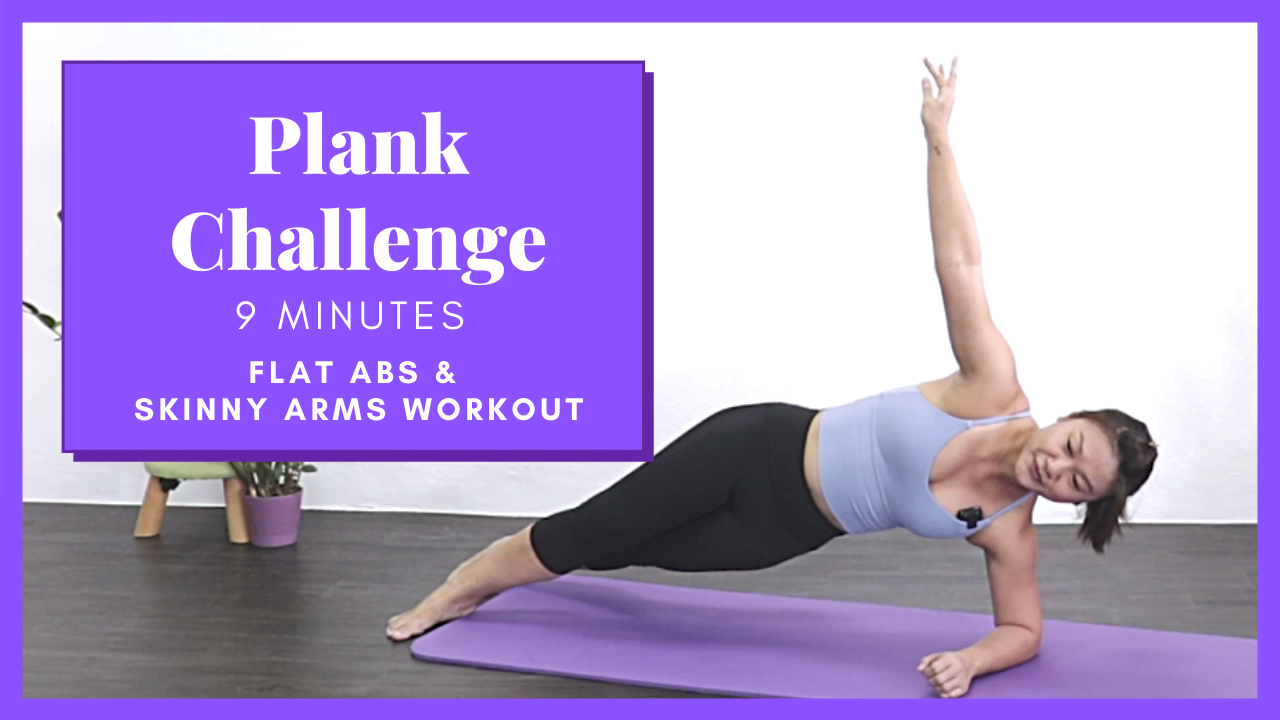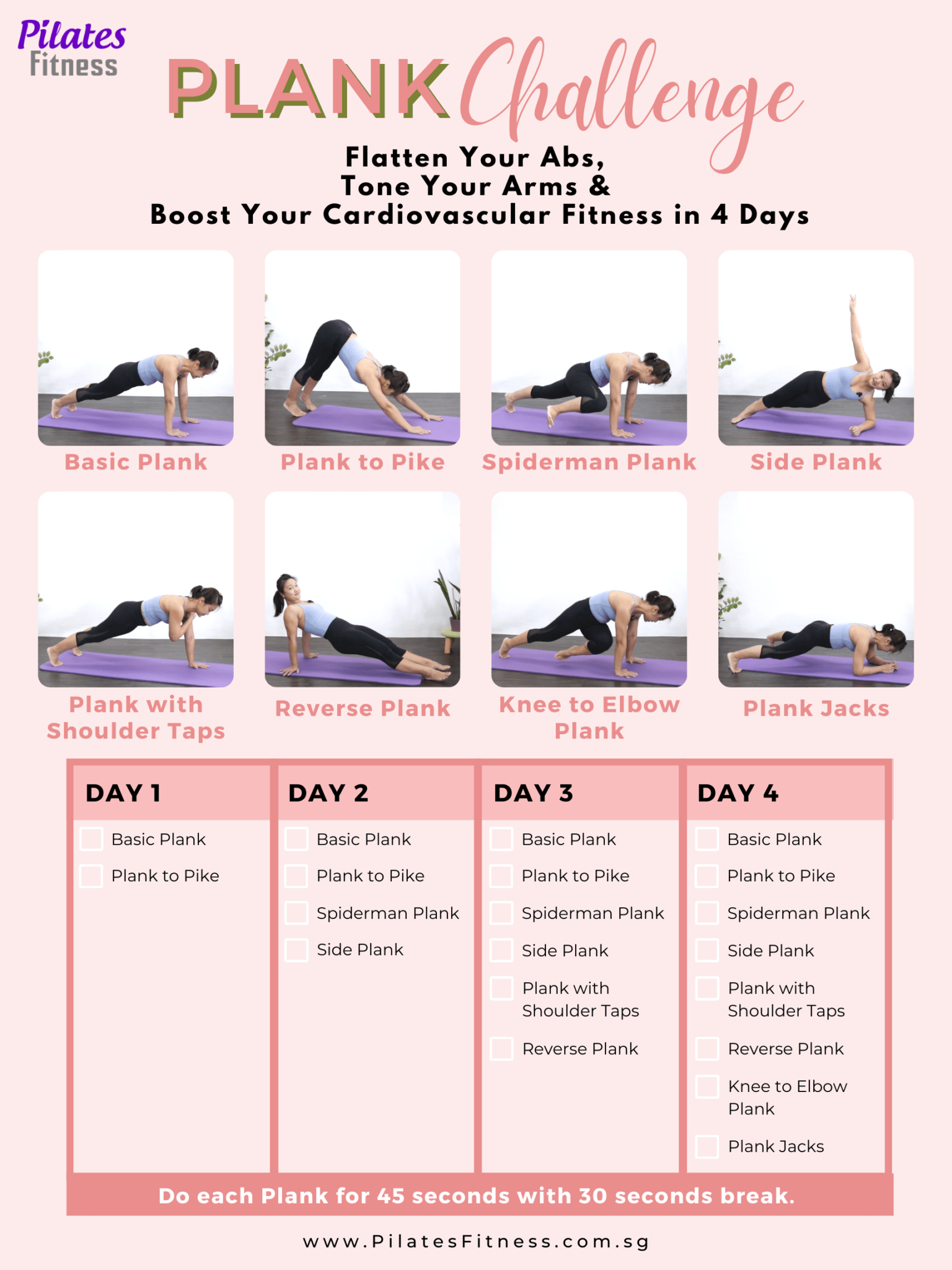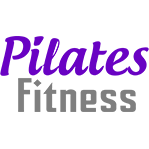
26 May 9 Minutes Plank Challenge | Upper Body Workout – Plank Variations – Beginner Workout
PLANK CHALLENGE
Pilates Fitness Plank Challenge is designed to strengthen your upper body and boost your cardiovascular fitness in just 4 days! Completing the Plank Challenge will take you through 8 different plank variations including the infamous side plank that not only tone your arms and abs but also stretch your shoulders and spine. If you are looking for an upper body workout or elevate your fitness level, repeat the Plank Challenge for 4 weeks – it only takes 2 – 8 minutes every day!
Candice will be guiding you step by step in the Plank Challenge to ensure that you keep the right muscles engaged this upper body workout. As Candice will be doing the plank variations together with you, she will cue the right spot at the right time when muscle / joint compensation are most likely to occur. Keeping the right form is the most efficient and effective way to reap the multi-benefits of plank.
Does Plank burn belly fat?
How long should a beginner hold a Plank?
Is it safe to Plank everyday?
What happens if I plank everyday for a month?
Does Plank help to ease body aches?
How does the Plank Challenge work?
What is a Basic Plank?
What is a Plank to Pike??
What is a Superman Plank?
What is a Side Plank?
What is a Reverse plank?
What is a Knee to Elbow Plank?
What is a Shoulder Tap Plank?
What is a Plank Jack?
Does Plank burn belly fat?
The basic plank is a static upper body workout and may not help much with spot toning your belly. However, doing plank variations, especially dynamic planks will help to increase calorie burn and tone your abs. So yes, doing different planks variations will burn belly fat and also improve your fitness endurance.
How long should a beginner hold a Plank?
Holding a basic plank for 45 seconds to 1 minute is ideal for beginners. If it is too tough, try to hold for 10 seconds with 5 seconds break and repeat continuously until you hit 1 minute. You can also explore plank variations such as side planks, reverse plank or plank jacks to spice up your exercise routine so that your muscles will not plateau over time.
Is it safe to Plank everyday?
Absolutely! Planking is an excellent upper body workout that also challenges your cardiovascular endurance, especially if you have knee/ankle issues. Planks work you hard while being relatively gentle on most joints. If you add on plank variations, it will be a effective and quick workout that you can do anywhere.
What happens if I plank every day for a month?
Planking daily for a month will get you a more toned torso, shapely arms and shoulders, improved fitness endurance, tighter glutes and more defined abs. If you plank correctly with proper engagement of glutes and abs, you will also feel the lower back body aches melting away each day you plank. With a proper diet, doing plank variations for a month will aid significantly to your weight loss goal.
Does Plank help to ease body aches?
One of the key advantages of planks is to strengthen your core / abdominal muscles. With a stronger core, you will get relief from most body aches issues. As the body learns to support your daily movements with a stronger core, there will be less joint and muscle compensation, therefore less strain on specific parts of the body. Planking also elevates your fitness level, so a stronger body will be less susceptible to general body aches.
DO YOU KNOW? Weak abdominal muscles place extra stress on our back muscles to support our posture, even during sitting or sleeping positions. Over time, this generally results in lower back pain. When the back muscles tightens up to protect itself from overworking, spinal range of motion is reduced and may translate into hip/knee/ankle pain as your spine is now unable to cushion pressure from your feet (when you walk). If this vicious cycle continues, you will end up with chronic back pain even though medical scans show that there is nothing wrong with you.
How does the Plank Challenge work?

Break for 3 days and repeat again. It is recommended to do the challenge daily and then let the body rest for 3 days before starting again. You can also combine this Plank Challenge with our previous Squat Challenge for a full-body workout.
[su_row][su_column size=”2/3″ center=”yes”][su_youtube url=”https://youtu.be/1p8M6HJQYkA” width=”1000″ height=”450″ responsive=”no”][/su_column] [/su_row]
What is a Basic Plank?
Basic plank is the original static plank that requires you to hold a somewhat push up position for as long as you can sustain the form. The plank is an isometric exercise – meaning you do not move as you exercise – it is an excellent workout to perform in a limited space environment. Since it pushes you rather quickly, it is also a great exercise to squeeze in when you have limited time. Simply holding the plank for 1 minute is a great perk-me-up in the middle of your day.
Basic Plank Tips:
- If you need pressure on your wrists – try to alternate planks between elbows and wrists.
- If you often feel the most pressure on the wrists/elbows, learn how to shift your bodyweight back to your feet – think digging toes into the ground or mat. You should have equal weight on your four limbs.
- If you feel lower back pain, draw your belly button up to your ribs and squeeze your glutes as you sustain the plank regardless of the type of plank variation
What is a Plank to Pike?
Plank to pike is essentially a shoulder mobility exercise. As you reach your glutes into the air into the pike position (like a downward dog position), think pushing shoulders towards your chest to form a nice long line from your wrist, elbow, shoulder, and hip bone on both sides. This hinging movement not only mobilizes your shoulders but also extends your spine and stretches your legs. It is a nice variation to your basic plank and gets some mobility work done.
Plank to Pike tips:
- Focus on shoulder mobility and spinal extension when you move from plank to pike
- Think reaching glutes to the sky as you extend your spine – you can bend your knees but you should not round your spine
- When returning from pike to plank, squeeze the glutes throughout the journey to avoid sinking your lower back when you are back at the plank position
What is a Superman Plank?
Superman plank adds hip mobility and leg workout to your basic plank. Due to the leg movement, you will be working harder on your obliques and shoulder stabilizer muscles. It feels like a side bend but you are bringing your hips up to your shoulders instead of another way around.
Superman plank tips:
- Do not rock on your toes and shift your heels when you bring your knee to your elbow
- Keep your shoulders on top of your wrist as you move your leg to work on shoulder stabilisers and prevent strain on your wrist
- Try your best to touch knee to the elbow as this will give you a really nice stretch on your sides
What is a Side Plank?
The side plank is a great exercise for strengthening the latissimus dorsi and obliques. Strong lats reduce neck and shoulder tension, and can even reduce migraines for some people. No one will mind a set of toned obliques. Moreover, the unilateral nature of side plank pushes your fitness level as you need to work on balance between front and back of the body, one side at a time.
Side plank tips:
- Ensure neck, shoulders and elbow are in a same line before lifting your bum and knees up into side plank
- Always use your top hand to give yourself a push to go into the side plank position instead of leaning onto your shoulder
- Keep reaching top hips towards the sky, bottom ribs pushing away from the floor as you glade shoulder blades down to engage your lats when sustaining a side plank
What is a Reverse Plank?
Time to reverse your traditional plank pose to make it even more interesting? Reverse plank opens up your chest and hips flexes, and work the glutes harder compared to a basic plank. This is a great exercise if you have bad posture issues.
Reverse plank tips:
- If you have wide shoulders, point your fingers out to the sides and keep the distance between your hands wider than your shoulders
- Keep reaching belly button to your ribs as you squeeze the glutes to maintain the position
- Eyes should NOT gaze to the ceiling, look in front of you as you push from the heels of your palm to work those abs
What is a Knee to Elbow Plank?
Knee to elbow plank brings you to a spinal flexion position and you will feel a nice burn on your abs everytime you touch your knee to your elbow. We have made this move more challenging by requesting you to touch both elbows. The twist to the inner elbow will work your obliques harder.
Knee to elbow plank tips:
- Do not rock on your toes and shift your heels when you bring your knee to your elbow
- Keep your shoulders on top of your wrist as you move your leg to work on shoulder stabilisers and prevent strain on your wrist
- You can round your spine in need to so as to touch knee to elbow
What is a Shoulder Tap Plank?
Plank with shoulder taps challenges your ability to balance your body in the plank position when one arm is lifted off. It is also a unilateral work for your arms and shoulders – a good opportunity to even out your arm strength.
Shoulder tap plank tips:
- Do not lean to one side when you lift your arm to tap your shoulders. Do not rock side to side as you do the repetitions
- Lift your arm up gently each time as sustaining the neutral plank position is more important than speed
- Keep the supporting arm long and straight with weight distributed across 3 limbs
What is a Plank Jack?
The plank jack is a combination of two very common exercises: the plank and the jumping jack. This is a great fat-burning exercise that combines both strength and cardio training. You can walk your leg out instead of jumping out if you have ankle issues.
Plank jacks tips:
- Land wider than the mat when you open and land legs together (inner thighs kissing) when land close
- Go onto your elbows as there is some pressure on the wrist due to the jumps
- Mix up with some arm movements if you want to add variations and fun!
We hope you enjoy the 8 plank variations in this Plank Challenge. If you enjoyed this upper body workout challenge, please and follow our IGTV (@sgpilatesfitness) so that you will be notified whenever we launch a new fitness challenge!
Stay fit and glow with Pilates Fitness!


No Comments